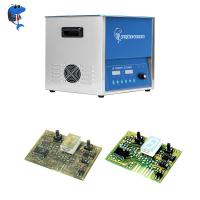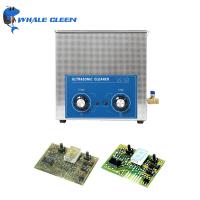200Watt 10L Ultrasonic Cleaner Electronics For Restoring Electrical
Board
What Can Whale Cleen sonic Ultrasonic Cleaner Electronics Do?
Dirt and dust can heavily affect the routine of printed circuit
boards (PCB) which are majorly found and used in various electronic
devices such as cell phones, multi-functional devices, electronic
parts, etc.
Since many years there are many queries regarding their cleaning
issues since, being a delicate part you cannot expect to clean it
manually. Thus it needs some skilled cleaning and recommendations.
Gadgets such as electronic ultrasonic cleaners help to clean these
delicate parts very effectively and are therefore used in various
technological departments, industries as well as repairing shops.
These devices are ideal for restoring and cleaning even complex PCB
boards and also for various other electronic components in a safe
and efficient manner.
Specification Of z-s04:
| Model | Z-S04(Digital Model) |
| Tank Material | SUS 304 |
| Package | Carton Box Packing |
| Tank size | 300x240x150mm |
| Unit size | 325x265x280mm |
| Carton packing Size | 435x360x350mm |
| Ultrasonic power range | 200W |
| timer | 0~30min adjustable |
| Frequency | 40,000Hz |
| Tank capacity | 10 Liter |
| pcs/carton | 1PCS/carton |
| N.W. | 7.4kg |
| G.W. | 8.5kg |
| Warranty | 1 year |
| Certificate | CE |
Cleaning Feedback From Customer:

How It Works?
Ultrasonic sound is generally defined as sound wave frequencies above the range of
human hearing, generally 20,000 cycles per second (20 kHz) and
higher. Ultrasonic cleaning is performed when the implosion of
billions of minute vacuum bubbles against surfaces of objects
immersed in an ultrasonic cleaning solution quickly and safely
strips away contaminants on those surfaces. Cavitation, the
formation and collapse of these bubbles, is produced by the
ultrasonic sound waves passing through the liquid. The sound waves
are in turn produced by the high-frequency vibration of
generator-powered transducers bonded to the ultrasonic cleaning
tank.
Ultrasonic cleaner transducers determine the ultrasonic frequency
generated for the cleaning process. Ultrasonic cleaners can be
specified to operate at frequencies such as 25, 37, 45, and 80 kHz
or higher. Some models operate at dual frequencies. The point to
keep in mind is the higher the frequency, the (relative) smallness
of the cavitation bubbles. Lower frequencies produce more vigorous
cleaning and are usually used for heavily soiled parts. As the
frequency increases, bubbles get (relatively) smaller for gentler
cleaning and with better ability to penetrate tiny cracks,
crevices, and surfaces typical of delicate PCBs used in
manufacturing medical devices.
How to Select and Use the Cleaning Solution
The wrong cleaning solution, just as the wrong ultrasonic cleaning
frequency, can do more harm than good. An ultrasonic cleaning
solution ideal for glass and ceramic substrates, optics, PCBs and
plastic parts is the biodegradable concentrate elma tec clean A1
available in 2.5 liter containers. It removes grease, oil,
activated fluxes, dust, fingerprints, light corrosion and residues
from coffee, tea, colas, milk and other sources.
Depending on the extent of contamination this concentrate is
diluted 3 – 10% with water. The recommended ultrasonic cleaning
time is 3 – 10 minutes at approximately 65˚C (150˚F).
Parts exhibiting more significant corrosion can be restored with
elma tec clean S1, also available in 2.5 liter containers. This is
diluted 1 – 5% volume with water and used at 65˚C (150˚F) for
approximately 2 minutes. But first check to be sure the corrosion
has not irreparably damaged the PCB.
After cleaning the parts must be rinsed in distilled or deionized
water. This is very important in order to remove any traces of
cleaning solution residue. Because tap water also will leave
residue deposits it must not be used as a rinse. Dry the components
thoroughly before reassembly.
Note that these are only guidelines. You should consult with the
ultrasonic cleaning professionals at Tovatech regarding equipment,
solutions and procedures to meet your requirements.














